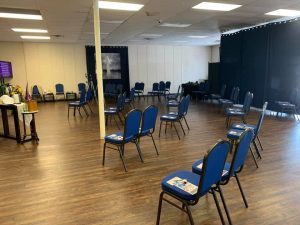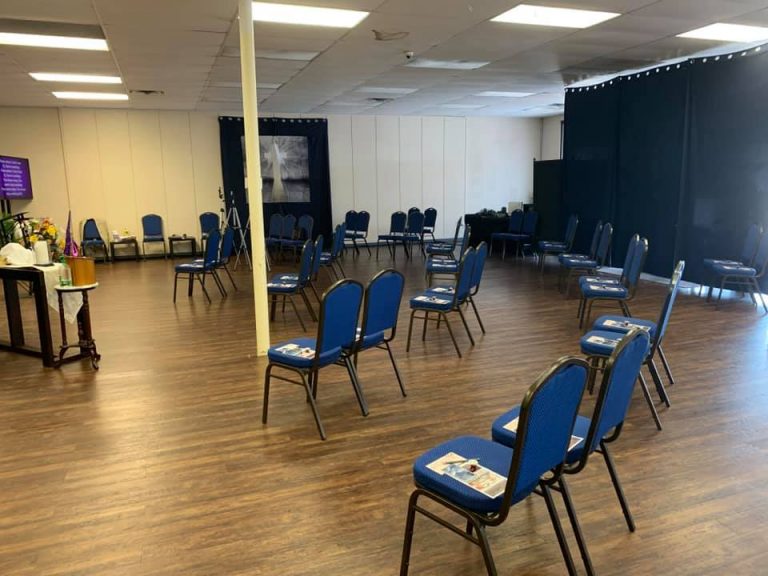“We are the church.” “Church is more than just a building.” You know the lines. And it’s true. I get it. But we all know those are unsatisfying answers. Why? Because we are social beings. It’s part of DNA. “Community” is essential to our sense of well-being, our sanity, our happiness — and (for most of us) for the expression of our spirituality. And Zoom meetings, as much as they *help*, are no substitute for in-person contact.
So what are we to do? Do we open our buildings or not? A number of my pastor friends are genuinely concerned for the safety of their people. To open the doors, to gather, they believe, would be to put their people at risk. And they are right to be concerned. A shepherd’s Number One job is to protect the sheep. But Covid is not going away anytime soon. So opening our buildings at some point seems inevitable.
And I think we can do it wisely and safely. Not 100% safe, of course. But practically, reasonably safe. And by observing the safety protocols health officials keep reiterating.
Small churches have it easier. With small congregations, it’s easier to spread out; it’s easier to influence your people to wear masks, not sit close. You can identify the high-risk types of activities and find alternatives. Here’s some of the things we did at our small church in Oklahoma City:
 We spread the seats out. We have movable chairs so this was fairly easy. If you have fixed pews, you may want to tape off every other row, and stack books or some other kind of divider every couple of feet on the pews to force people to space out.
We spread the seats out. We have movable chairs so this was fairly easy. If you have fixed pews, you may want to tape off every other row, and stack books or some other kind of divider every couple of feet on the pews to force people to space out.
Spread out your musicians and praise team. And have them stay farther back from the seats.
Put away the donuts and coffee for now. Too many hovering faces and hands.
Passing the Peace or “meet and greet,” well, you can get creative here. Encourage people not to get too close and to stand at least arms length apart if they talk (with masks, of course!) Instead of shaking hands or hugging, elbow bump. Or invite them simple to make eye contact across the room, give a thumbs up or a peace sign, a friendly nod of recognition — something that says, “I see you; I’m glad you’re here.”
Offering: instead of passing a plate, where many hands touch the same surfaces, encourage on-line giving. PayPal is easiest (and almost every church and everybody has access to it.) Of course there are fees. Google Pay and Apple Pay are other options your under-40 people will likely be familiar with. And for those who still give by check or cash, get yourself a donation box (easily obtainable at Amazon, for example), put it on your altar or near your communion elements, and make it part of your worship, that anytime during worship or prayer, people can feel free to come up and insert their offerings, prayer requests and praise reports. (By including prayer & praise cards you reduce the “bragging” stigma of “hey, look at me putting money in the box!”.)
Communion: there are a number of options. Obviously, sharing a common cup is not a great idea right now. You can use the prepackaged, single-serving kits that come with a wafer and (what tastes like) Kool-Aid, and leave them on the seats. Admittedly, peeling back the plastic wrapper is not the most “sacred” of feelings, but by stressing the meaning of the activity over the actual elements, can go a long way. Or you, as minister, can hand out the wafers and single-serving cups at the altar, spaced out. (And of course, you’ll be wearing your mask and gloves while handling the elements.)
For larger congregations, consider limiting capacity to 1/3 your normal size, so you can spread out, and going to multiple services. It’s more work, takes more coordination and advanced notice to your people, but can be worth it. And hey, like some churches and synagogues do at high holidays, you could even invite people to “make reservations” for the service they want to attend so you don’t have people waiting in the parking lot.
For those people who still don’t feel comfortable being out in public, by all means, continue to broadcast your services on Facebook live, Zoom, or whatever other media platform you use.
And of course, over and over, remind your people that wearing a mask is “loving your neighbor,” it’s being your brother’s keeper. It’s what Jesus would do.
None of this is perfect. But with a little creativity, you can minimize exposure risk so that you can still enjoy gathering for worship and have that sense of “I’m not in this alone.”


